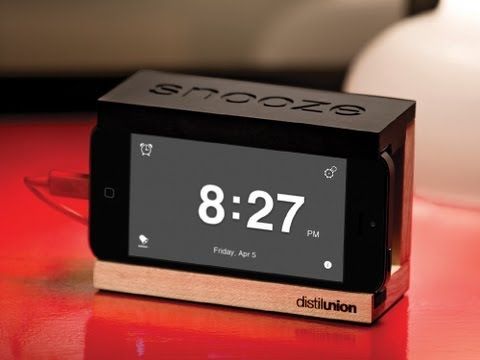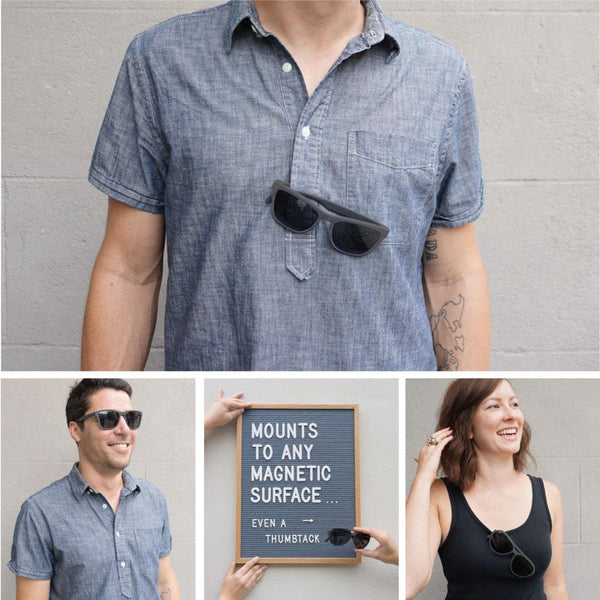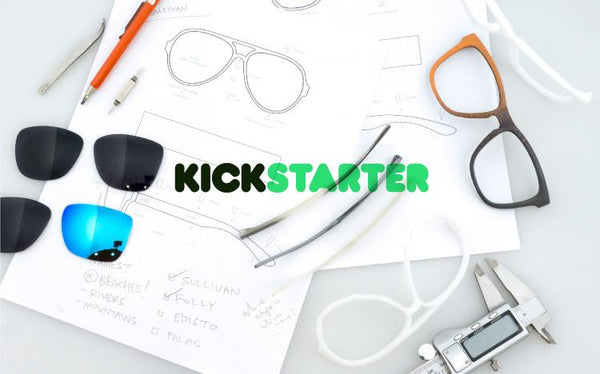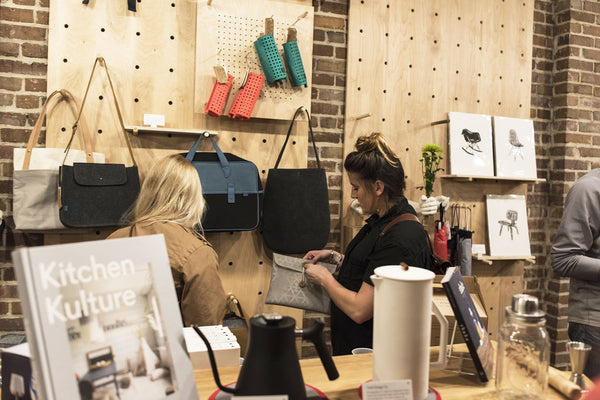A pair of designers based out of Charleston, S.C., is determined to solve life’s most common frustrations with modern design.
Nate Justiss and Lindsay Windham founded Distil Union in 2011 with Justiss managing industrial design and Windham as art director. The two met while working at a big-box store in Charleston, designing hundreds of mainly Apple accessories. When the business closed, both took on contract work before eventually deciding to form the design collective that is now Distil Union.
The new business had a firm goal in mind: to create products that improve experiences in people’s everyday lives.
The first such product solved the problem of knocking your iPhone off of the nightstand as your alarm blares early in the morning, leaving you to stumble out of bed to find it and hit snooze. Inspired by their own personal experiences and conversations with friends, they sought out a solution.
“When we start to question those little annoyances, a lot of the times there are interesting product solutions there,” says Justiss, with Windham adding, “A lot of the time, you’re thinking why does this always happen? Or there’s got to be a better way! That’s a really good opportunity to create something and bring it to the market.”
The first problem-solving design was a minimalist wood iPhone dock with a big rubber bar on the top. When the user would hit the bar, the product would snooze the iPhone.
 The sleek and simple design was welcomed by the Kickstarter community, who were eager for a new product to replace the big, boxy iPhone docks that were the norm at the time. Seven more Kickstarter campaigns and resulting products followed, and the duo is continuing to produce modern design solutions.
The sleek and simple design was welcomed by the Kickstarter community, who were eager for a new product to replace the big, boxy iPhone docks that were the norm at the time. Seven more Kickstarter campaigns and resulting products followed, and the duo is continuing to produce modern design solutions.
Transitioning from Big-Box Store to Business Owners

When Justiss and Windham left the big-box company, they spent about a year doing contract work while thinking up their business. Even after Distil Union was formed, they continued to supplement the business with contract work for the first two to three years after. During this time, Justiss was helping inventors launch their products while Windham was working with artists and musicians doing freelance marketing, copywriting, and web content creation.
This additional work helped feed the pair and got them to a point where they could focus just on their business.
Once we moved over to the business full time, we weren’t making a whole lot of money. Things sort of accelerated after we were able to focus,” says Justiss.
He advises learning to “live lean” while in this transition period. Windham describes this flex period as a little like their time in university — complete with ramen noodles, sandwiches, and a tight budget.
“When you have just the constant adrenaline of having your own company and trying to make it work, it felt a little bit like college,” she says. “The best advice that I can give is to learn to live off of very little. It really does free you up to be able to make that leap,” says Justiss, whose apartment served as their studio for the first few yearsof the business.
While doing contract work, Windham also turned to technology to simplify her new responsibilities as a freelancer. She recommends using tools such as FreshBooks, the cloud-based accounting software. Now Windham turns to tools such as StitchLabs for inventory and ShipStation for fulfillment, making good use of the automation features.
“I wasn’t particularly great with the business side of being a freelancer, invoicing, and giving quotes and things like that. If you can make it easy on yourself, you can still get sleep,” says Windham.
The Kickstarter Model

Justiss and Windham launched their first product on Kickstarter in 2012 at a time when the concept of crowdfunding was just catching on. The launch enabled the duo to get the cash flow they needed to operate their business and gave them a direct line to their customer base.
We were able to pay for manufacturing — we could manufacture enough to fulfill the Kickstarter pledges, and have inventory remaining so we could sell it on our website.
"That was sort of how we built momentum. That really worked for us and we still do that,” says Windham.
It was important to the co-founders that they not take outside investor money which could influence the product design, as had been the case in their previous employment. Both had supported other Kickstarter campaigns and felt comfortable giving it a shot. At the time, they needed $50,000 to design their first product and had only invested $9,000. The shortfall was the deciding factor in launching a Kickstarter campaign, and it paid off.
“That platform has really enabled us to keep launching products that the world needs. Simplifying your daily life a little bit, that’s what we get a kick out of doing. We are going to keep doing it as long as we can,” says Justiss.
Their second Kickstarter campaign surpassed even their highest expectations, overachieving its goal by 827%. The product was an iPhone accessory which solved the problem of carrying your cards on the back of an iPhone in plain sight. With the goal of reinventing bulky card wallet cases, the duo launched the Wally Stick On.
While they had sworn they would never do another phone case after designing hundreds of them for stores like Best Buy and Target, this accessory had a different personality.
“So, we made this really slim, sleek, leather pocket and a pull tab and a micro-suction back that you can stick directly onto your phone. That’s one reason Kickstarter worked for us,” Justiss says.
“We were doing something that we couldn’t find in stores because it was a little weird, a little niche, a little different. That’s what people a lot of people who are drawn to Kickstarter are these early adopters and they are people who want something a little different.”
While the accessory was their most successful product on Kickstarter to date, raising $90,000, Kickstarter is not always indicative of mainstream success, says Justiss. A second variation of the iPhone accessory was a classic case/card combo and raised just $20,000 but performed better than the original on Distill Union’s website.
“The Kickstarter early adopter niche is a little more accepting of ideas that are very different, whereas the larger consumer group, those who aren’t early adopters, are going to go after standards like a case,” explains Justiss.
Justiss and Windham urge entrepreneurs who are using the Kickstarter model to have a thorough understanding of their costs before launching. Measures such as having a more robust cost of goods spreadsheet and considering costs such as shipping and taxes are important considerations.
“Bulk up what you think you need. If you think you need $10,000, then try to have 20 or 30% more than that to help with the surprises that usually pop-up along the way with product development,” says Windham, who also advises to keep things simple and not let pledge levels get too complicated.
Building Manufacturer Relationships

One area of the business which did not come with unexpected surprises was with manufacturing relationships. Justiss knew the supply chain processes from his previous position and used his manufacturing relationships to help get Distil Union up and running.
“The manufacturing relationships that we had coming out of that [job] really allowed us to go back to some of those folks and work with them. They gave us a chance when we were a new brand with some wacky ideas. We could trust them, we worked with them before, and they trusted us. It was a huge boost. That was really our value starting the company together,” says Justiss.
Justiss and Windham know how to develop a product via email or Skype conversations with their manufacturers, but prefer good old-fashioned face-to-face communication. They say that visiting the factories speeds up development and improves the quality of the final product with the ability to review the product as it comes off the production line.
“There’s just a lot of nuance when you are both sitting there with a sample and are able to point out things and sit down with say the pattern maker and explain these things that either need to be improved or expedited. There is no substitute. It's a fairly small investment for what you can get out of it,” says Justiss.
The effort of flying across the ocean is also not lost on their business partners, says Windham. While on these trips, the pair, eat, drink, and spend a significant amount of time with their partners, strengthening the relationships.
“These guys we have known now for years and they have become friends. Being able to visit in person is great on the personal level, but also, like Nate said, going to the factory, seeing the process, it’s just priceless,” says Windham.
Pop-Up Shop Intel

Human interaction also proved to be the most valuable takeaway when launching their pop-up shop, called the Objective Design Shop. With a goal of bringing modern design to Charleston, Distil Union opened shop in their new studio on King Street in November 2015.
One of their team members had interior design experience, so they set about designing a retail space that was originally intended to offer four brands. Due to the minimum ordering requirements from certain brands, the pop-up quickly grew to offer 400 different products in-store.
With a “pop-up” being a relatively new concept at the time, it was even more unusual for it to last two holiday shopping seasons over the course of its 15-month lifespan.
“The initial dream for our business was to have an open workspace so we could have a dialogue with people who are curious about industrial design. We wanted to have sort of a workshop — a mixed-use space so we can bring modern design to Charleston, which is a very historical town, and have a dialogue with people,” says Windham.
While Windham describes the pop-up shop as a dream come true, it was also a major distraction from their business, which was operating in the same space. They ended up hiring a shopkeeper to help maintain some balance, but also took the opportunity to get valuable feedback from clients.
“One of the most valuable things to me was seeing how people interacted with our products in a store. Here, we are selling mostly online. It was apparent that maybe some changes needed to be made for success in wholesale,” says Justiss. “It was more of an education than it was a revenue generator.”
The duo gained a lot of insight into how to make it easier for wholesale clients to order by having to go through the same process with other brands. Windham stresses the importance of free shipping, making the ordering process easy, and ordering with a code rather than an email.
She also used Shopify articles as resources when initially researching the pop-up concept and used Shopify POS. They kept all vendor information in a Google spreadsheet and then would upload to Shopify to sell additional inventory.
TRY SHOPIFY POS: For a robust point-of-sale system to power your own pop-up shop or storefront, check out Shopify POS.
Windham’s advice to other entrepreneurs is to consider all possible costs associated with a pop-up, keeping in mind shelving and displays, staff, and hosting events.
“Be super clear with yourself on your budget and what your goals are,” she says.
Getting Your Message Across
Distil Union - We're designing things to make life a little better. from Distil Union on Vimeo.
The pop-up shop also fed back into product messaging, with Windham and Justiss available to answer people’s questions and then relate that experience to messaging on their packaging and website. Over the years, Windham’s methods as a marketer have changed to mirror the ways in which consumers are experiencing products.
“Sadly, I have learned people don’t really read packaging. Keep the message super simple. Now it is so much easier, we have social media to tell stories and do video and to have a lot more interaction. It’s a much different experience now,” says Windham.
YouTube videos with influencers have been a big referral for Distil Union. They’ve worked with influencers like Excessorize Me, a YouTube channel dedicated to iPhone case reviews that boasts more than 114,000 subscribers.
“When other people are talking about our products, whether it is a blog post or a review on a YouTube channel, those are the best traffic for us. We can do Facebook ads all day, but you don’t get better at targeting a certain market,” says Windham.
Windham has worked with PR teams previously in an effort to replicate positive results, but found that ROI was increasingly difficult to measure. Distil Union’s best publicity has happened organically, as was the case with a Slate article that brought the brand major attention.
“Having a good product out there ultimately is how you get good PR. Our wallet was on Amazon with hundreds of other men’s wallets and somebody who bought it loved it and emailed us for an interview and it was Slate.com. He wrote the most amazing review,” says Windham. “Usually when I email someone cold, I’m not going to hear back. But because of his experience with the product was so good, it was such a genuine interest that I think that really came across.”
Now Distil Union maintains its relationships with a small group of bloggers and YouTubers who tap into their audience. Rather than trying to reach out to each and every influencer, Windham maintains organic relationships with influencers who have proven to be a good match for her customers and for reaching new people. The team has focused their PR outreach to hone their efforts on what they do best: product design.
“We spent a lot of dollars trying to advertise and recreate that buzz. We are sort of pulling back and focusing on launching good products. That’s what we know we do best: designing and launching products. We have got a few in the pipeline that we are going to launch on Kickstarter again and try to get the word out and put good product in front of people,” says Justiss.
Whether it’s knocking your iPhone off the nightstand, or a mode of transportation for credit cards, Distil Union proves that modern design can be injected into mundane everyday moments.
Read more
- What Happens When 3 Friends Work to Make the Perfect Custom Shirt and Bring Manufacturing Back to America
- How Greenery Unlimited Uses Shopify POS Pro to Manage Their (Literally) Growing Inventory
- How a San Francisco Indie Wine Store is Attracting International Customers
- From Side Hustle to Social Enterprise: How One Designer Found a Fan in Sophie Trudeau
- How HERO Backpacks Founder Used Her Personal Story to Build a Brand
- How Ryzon Increased Store Conversion Rates by Over 40% with Shopify POS
- How This Mattress Retailer Went From Clicks to Bricks With a Dream Gallery
- How This Canadian Footwear Brand Is Finding Success Focusing on Heritage and Style
- How These Four Founders Built a Premium Bedding Brand From Scratch
- How This Entrepreneur Created a Workwear Line With No Fashion Experience





